My Cajun Seafood Gumbo Recipe
Welcome to the heart of Cajun cuisine, where bold flavors and rich traditions come together. This authentic Louisiana Cajun Seafood Gumbo is a soul-warming stew inspired by all my family’s cajun gumbo recipes.
Originating from Louisiana’s vibrant and diverse food culture, this gumbo is a testament to the Cajun love for combining various ingredients into a harmonious, flavorful meal.
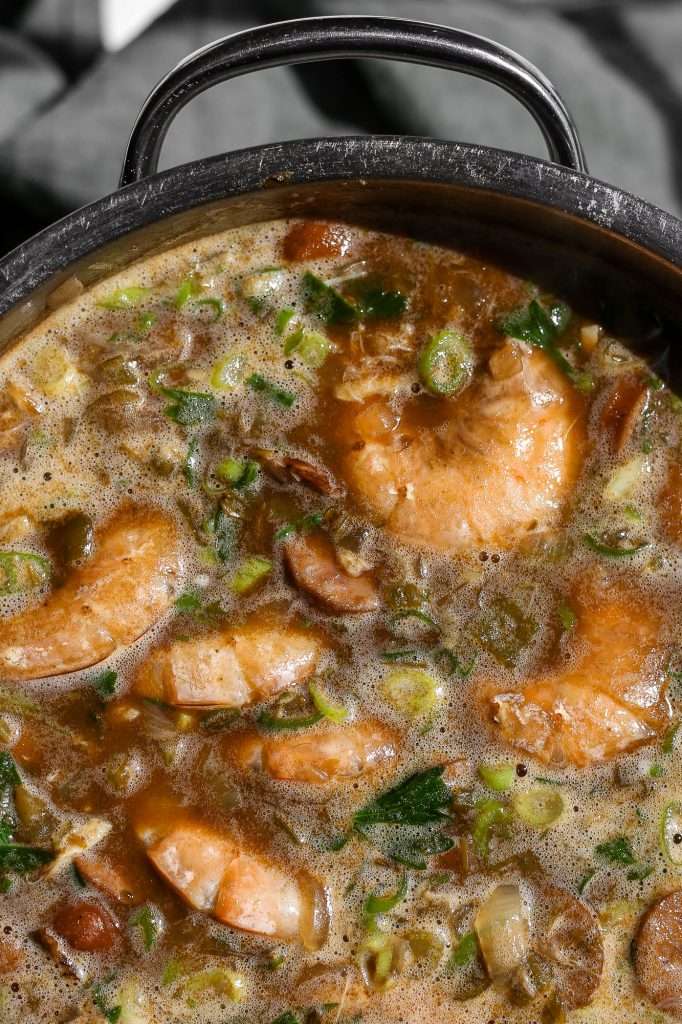
This cajun seafood gumbo starts with a dark roux, a creamy base that lends an unmistakable depth to the dish. As it simmers and transforms into a deep mahogany hue, the roux captures the essence of Cajun cooking, setting the stage for an unforgettable flavor.
I went a bit fancy in this recipe, adding a treasure trove of my favorite seafood. Succulent crab meat, plump mussels, and tender shrimp combine to create a symphony of seafood flavors that meld seamlessly with the roux’s richness. The result is a gumbo brimming with warmth, spice, and a local flavor.
Each spoonful is a taste of the very essence of Louisiana’s culinary heritage. So, roll up your sleeves and prepare to feast on the best soup in the world as you cook this classic Cajun Seafood Gumbo.
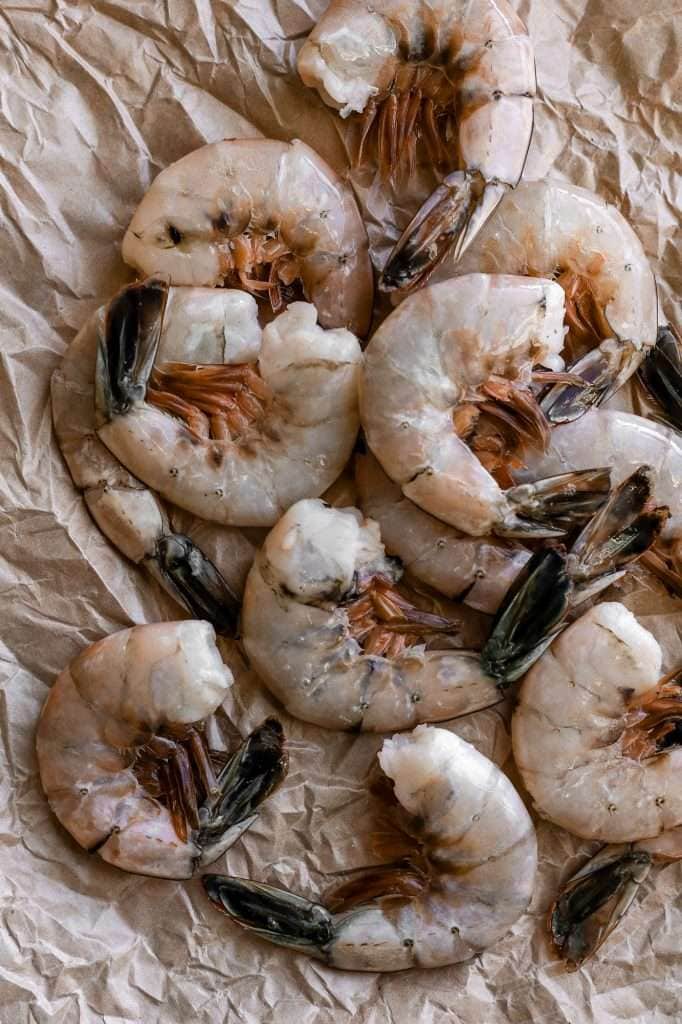
Louisiana Seafood Gumbo with Mussels and Shrimp
Here are all the ingredients you need to make this delicious cajun seafood gumbo:
- 1 cup organic flour
- 1 cup tallow or lard
- 2 large yellow onions, chopped
- 2 green bell peppers, chopped
- 8 celery ribs, chopped
- 1 cup of warm water
- 1/8 cup fermented hot sauce (optional)*
- 12 ounces smoked andouille sausage, sliced
- 1 tablespoon cajun seasoning*
- fresh oregano, chopped
- 1 tablespoon garlic powder
- 1 tablespoon onion powder
- 6 cloves fresh garlic, minced
- 8 bay leaves, whole
- 8 cups beef stock*
- ½ cup fresh parsley, chopped
- 1 cup green onions, chopped
- (peel on or peeled) 1 lbs shrimp
- 1 lbs mussel meat
- 1 lbs crab meat
Equipment you need:
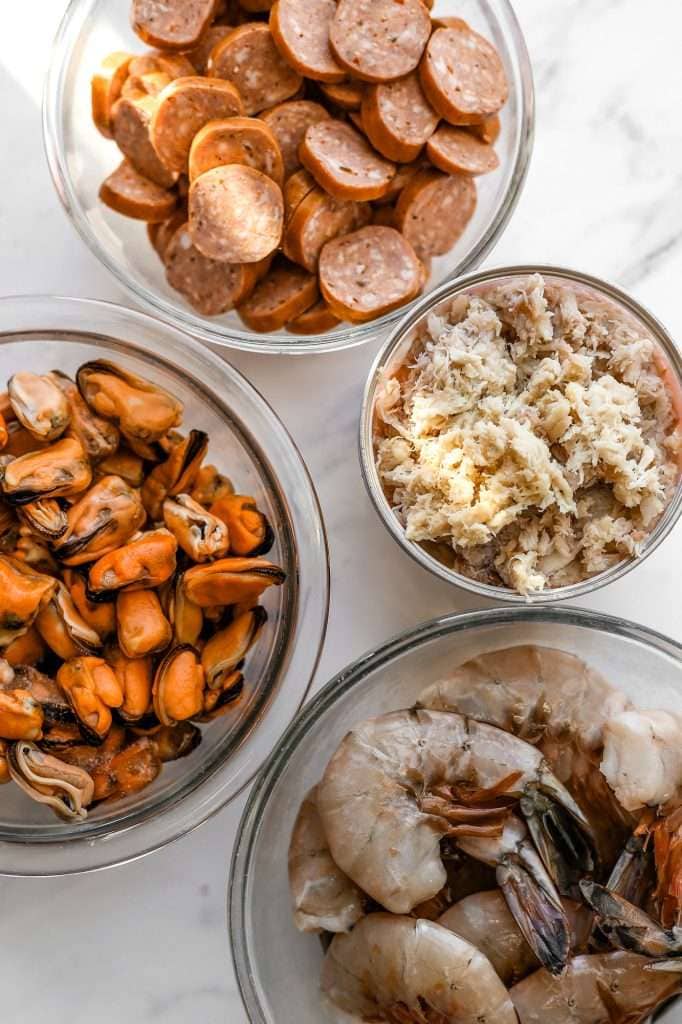
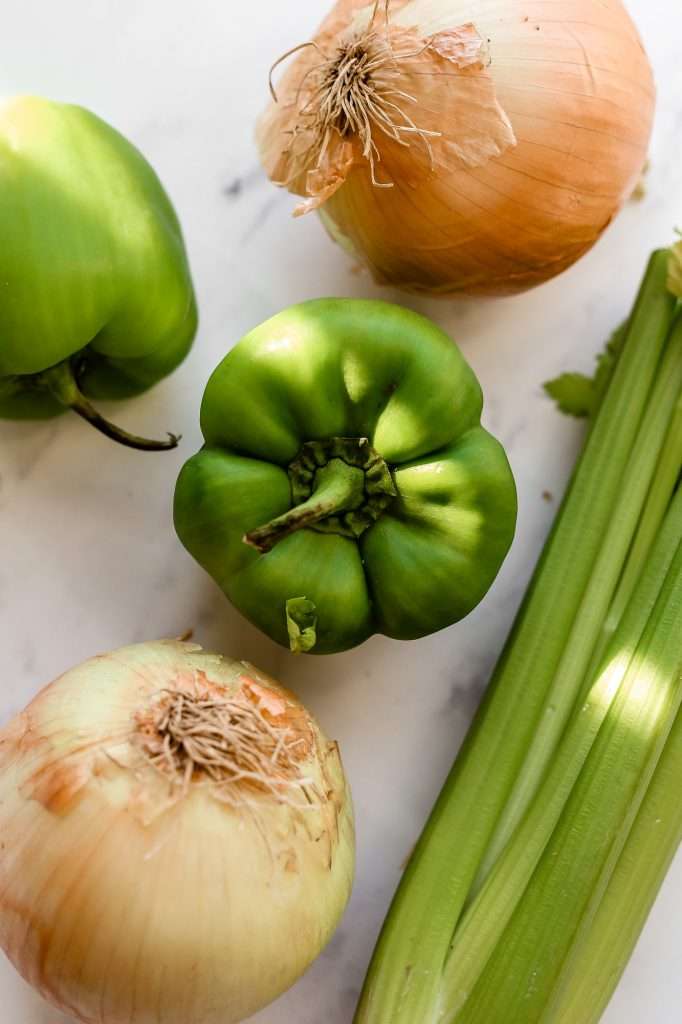
How to Make a Roux for Cajun Seafood Gumbo
Making a roux is not as difficult as you may think. I swear by a few rules when making a roux. These rules will help you out if it’s your first time.
- Always use animal fats. We’re talking about tallow, lard, and duck fat. These fats are nourishing, good for you, and stable at high temperatures. While you can use other oils to make a roux, animal fats work best for flavor and significantly help with not burning the roux.
- Before you start your roux, ensure you’ve chopped the trinity (bell pepper, onion, and celery) and placed it near your cooking pot so it’s ready. Also, place a cup of water near you. You will use the water after you add the trinity to the roux. You want these ingredients near and ready to go, so you never leave the roux unattended.
- Always use a wooden spoon, wooden spatula, or roux spoon.
- Pour yourself a glass of water, sweet tea, or lemonade, and have that near your cooking pot too. Turn on some good music. You’ll be here a while (like 15-20 minutes, maybe).
- Do not stop stirring, making sure to scrape all curves and sides of the pot all the time.
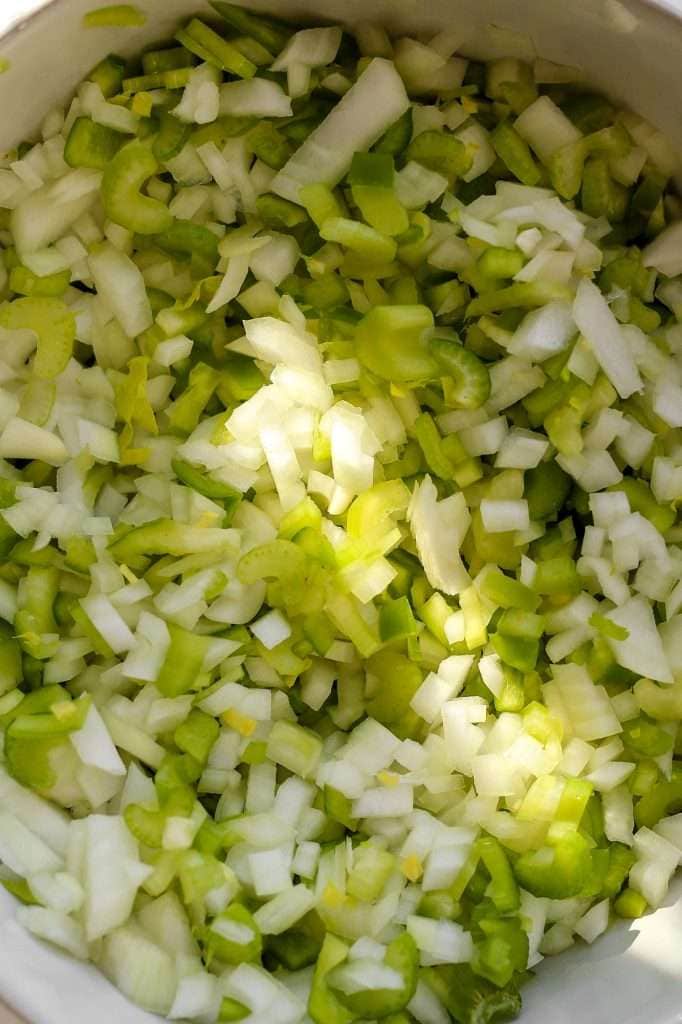
The Steps of Making a Roux for Gumbo
The roux starts off the same color as the flour you use. As you continue to stir it, it will turn to beige, then peanut butter. Once you get to peanut butter, it’s time to pay attention closely.
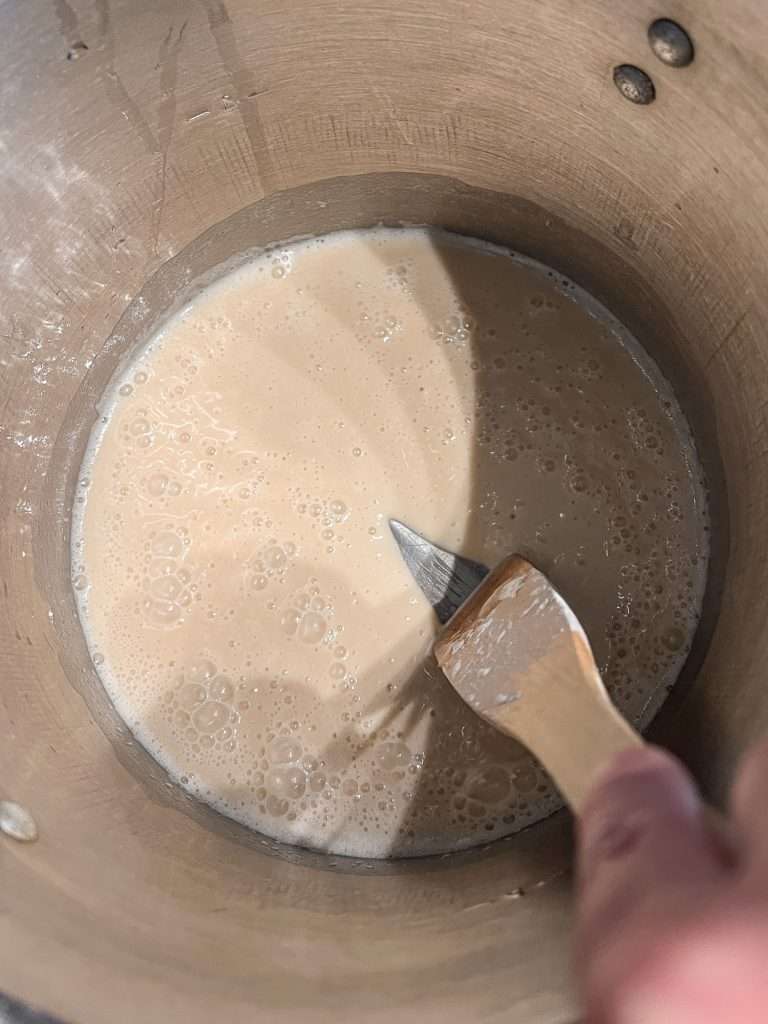
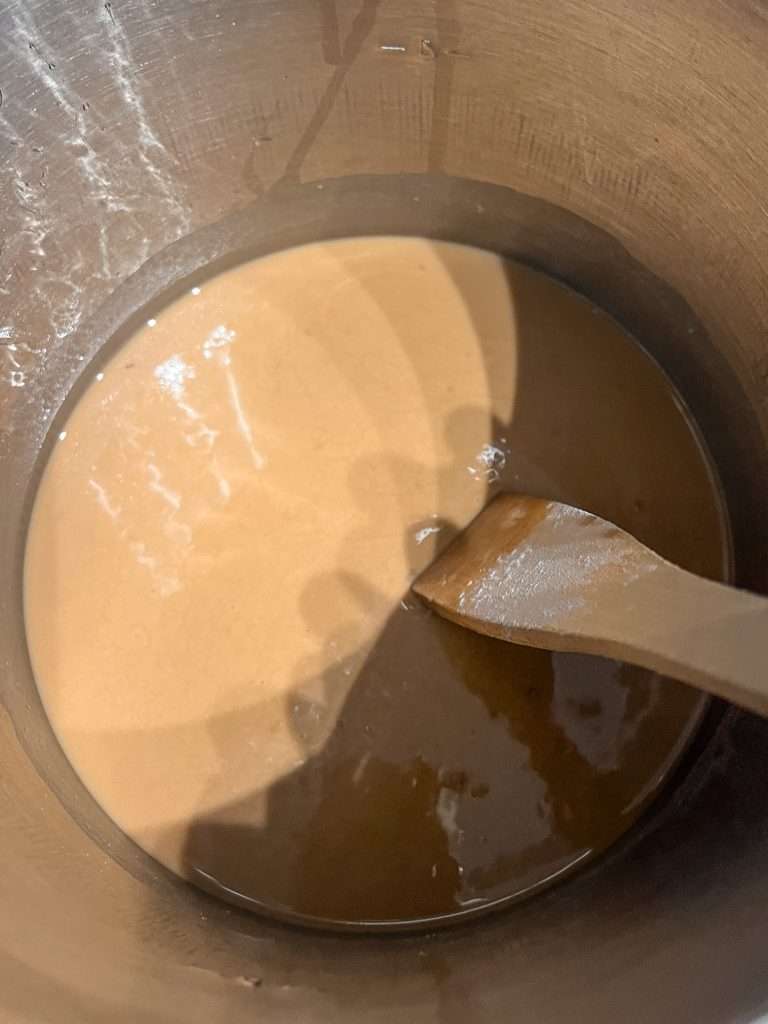

The goal for cajun seafood gumbo is a dark roux, and I like mine to be the color of milk chocolate. Once you reach milk chocolate, immediately add in the chopped trinity and stir to coat.
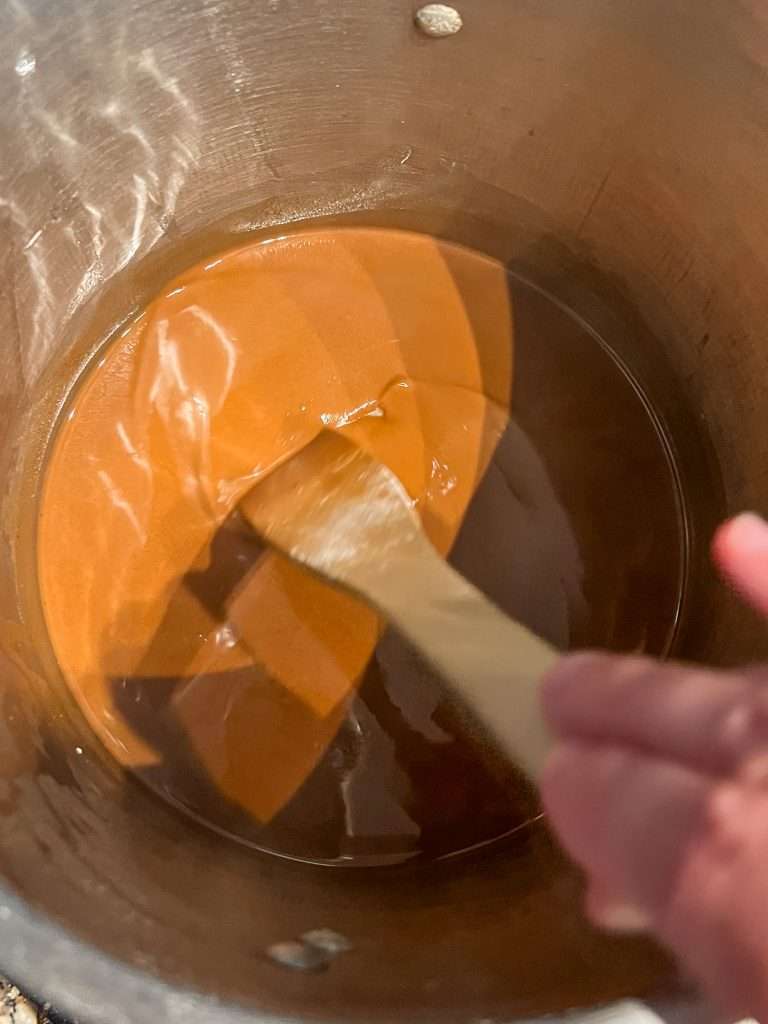

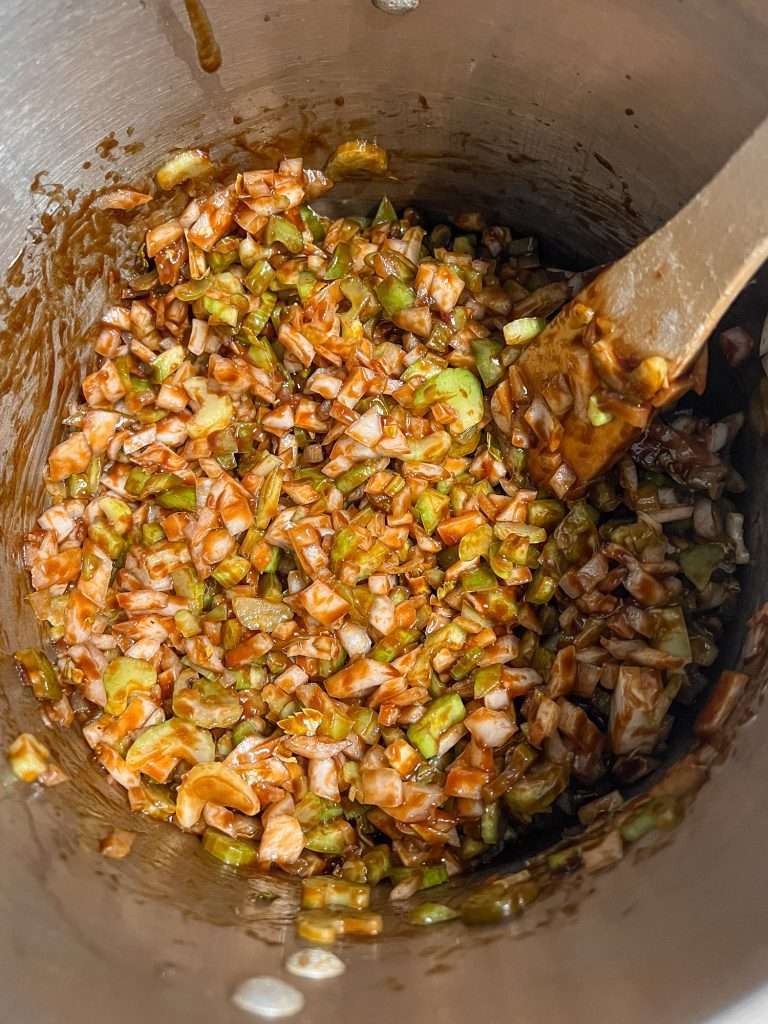
As you mix the trinity into the roux, it will look dry and possibly clump. This is when you will slowly trickle the cup of water into the mix. Keep stirring as you add in a little water here and there. Once the mixture is smooth and the trinity becomes translucent, you can add the sausage.
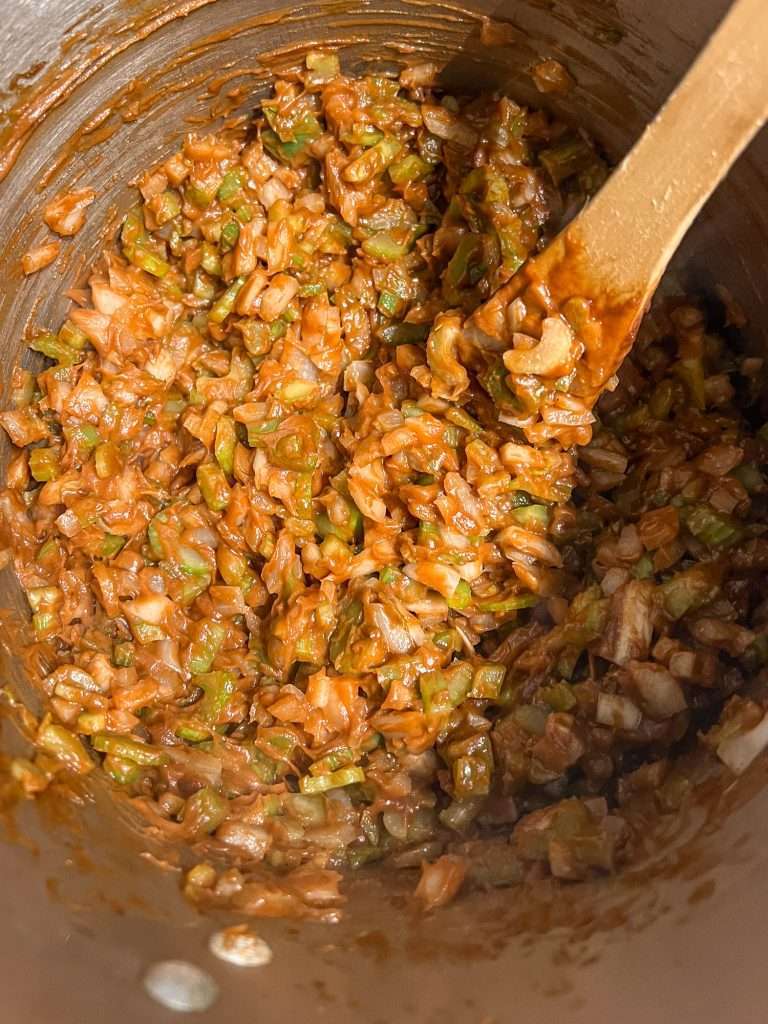
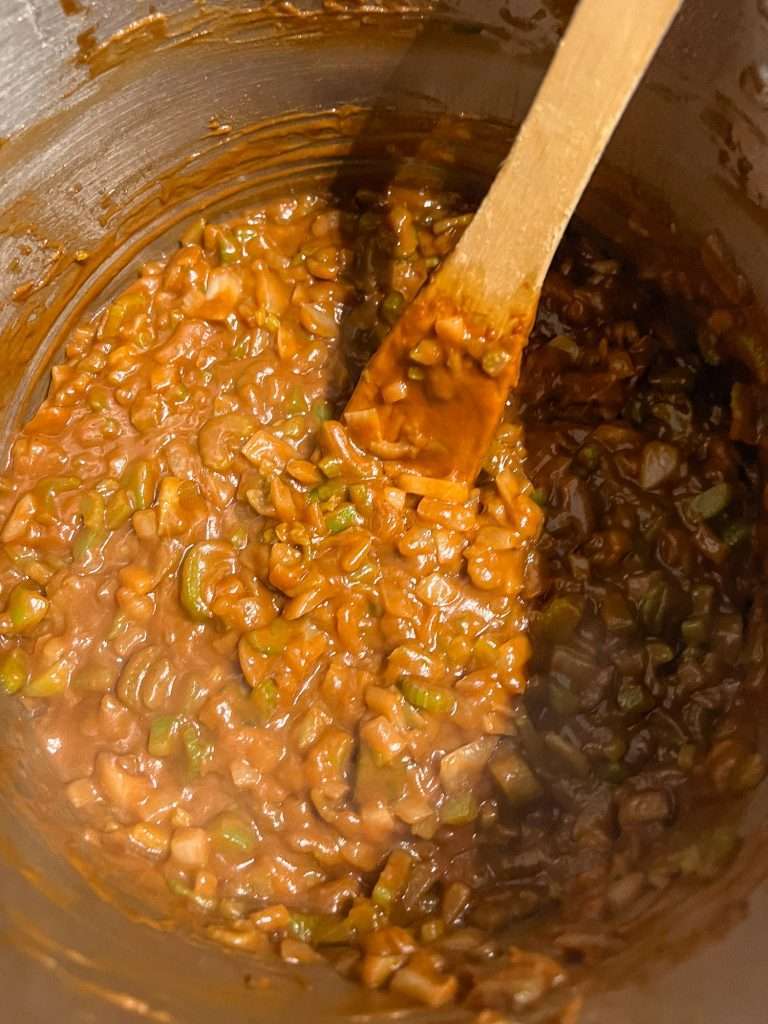
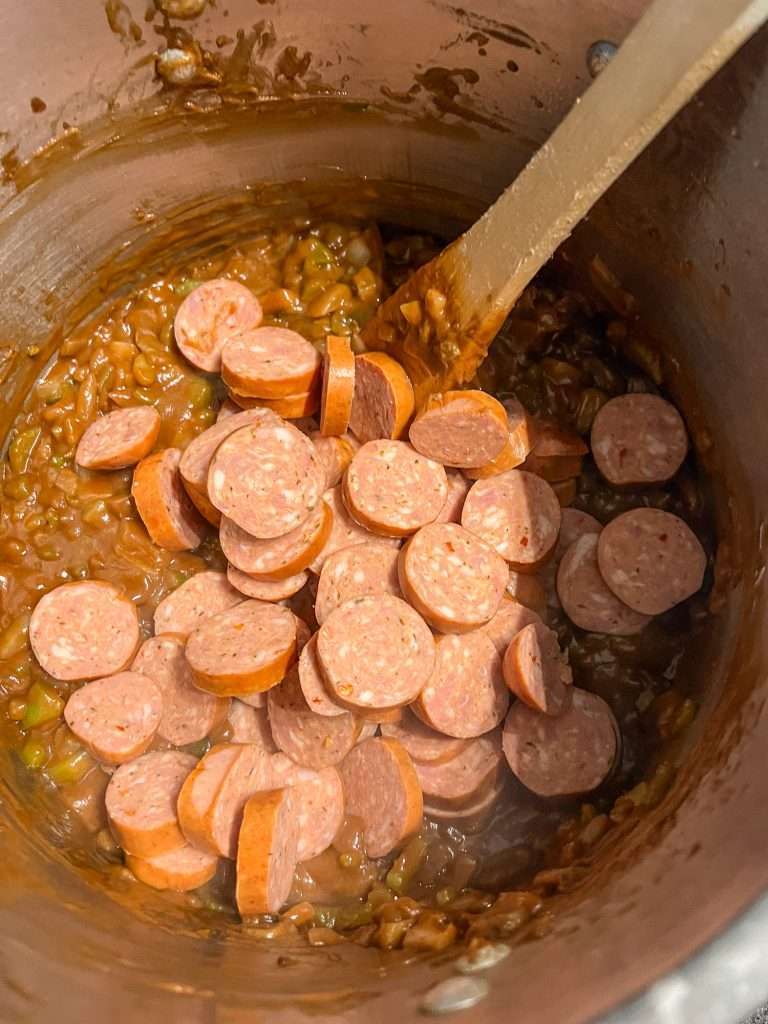
Do You Have to Use a Roux in Cajun Seafood Gumbo?
For my recipe, yes, you need to use a roux. Some gumbo recipes do not call for a roux, though.
File powder and okra are two common ingredients used to thicken gumbo without a roux. Here’s how each of these ingredients works to thicken gumbo
File Powder:
- What is it? File powder (pronounced fee-lay) is ground sassafras leaves. It’s a traditional thickening and flavoring agent used in many Cajun and Creole dishes, especially in Louisiana.
- How it works: File powder thickens gumbo by absorbing excess liquid and giving the broth a slightly silky texture. It also adds a subtle earthy and herbaceous flavor to the dish.
- When to use it: File powder is typically added right before serving at the end of the gumbo cooking process. It can become stringy if you add it too early and let it boil.
- How to use it: Sprinkle file powder on top of each serving of gumbo, or you can offer it at the table as a condiment for diners to add to their servings according to their taste.
Okra:
- What is it? Okra is a green, seed-filled vegetable commonly used in Southern cuisine. It’s known for its natural sliminess, which can act as a thickening agent in gumbo.
- How it works: The natural mucilage (a slimy substance) in okra helps thicken the gumbo as it cooks. The okra pods release this mucilage into the broth, creating a thicker consistency.
- When to use it: Okra is typically added earlier in the gumbo-making process, often during the initial sautéing of vegetables and before you add the liquid and other ingredients.
- How to use it: Slice fresh okra and add it to the pot while sautéing the onions, bell pepper, and celery. If you’re using frozen okra, add it to the pot during the simmering phase of cooking.
You can use file powder, okra, or a combination of both to achieve your gumbo’s desired thickness and texture. The choice between okra and file comes down to personal preference and the regional variations in gumbo recipes. Using file powder is an excellent option if you prefer gumbo without okra. If you enjoy okra’s natural flavor and texture, you can use it as a thickening agent in your gumbo.

Louisiana Crab Gumbo with Mussels and Shrimp
Many people have tried to make gumbo “healthy” by adding vegetables that don’t belong to it. The thing is, gumbo is already healthy if you use good ingredients!
Seafood such as crab, mussels, and shrimp offers many health benefits, making it a delectable and nutritious choice. Here are some of the health benefits of all the delicious seafood included in this cajun gumbo.
Crab:
- Low in Calories and Fat: Crab is a lean source of protein, making it a favorable option for those aiming to manage their calorie and fat intake. It’s rich in protein, providing essential amino acids for muscle repair and growth.
- Abundant in Vitamins and Minerals: Crab is a noteworthy source of essential nutrients like vitamin B12, which supports nerve function and the production of red blood cells, and zinc, which is crucial for immune health, wound healing, and DNA synthesis. It’s also packed with selenium, a powerful antioxidant that protects cells from damage.
- Omega-3 Fatty Acids: While not as rich as some other seafood, crab still contains heart-healthy omega-3 fatty acids, which may reduce the risk of heart disease and provide anti-inflammatory benefits.
Mussels:
- High in Protein: Mussels are an excellent source of protein, which is essential for overall health. They provide all essential amino acids, making them a complete protein source.
- Rich in Vitamins and Minerals: Mussels are a treasure trove of essential nutrients, particularly vitamin B12, iron, copper, and selenium. Vitamin B12 is vital for neurological health, iron supports oxygen transport in the blood, and selenium is an antioxidant that helps protect cells from damage.
- Omega-3 Fatty Acids: Mussels are a superb source of omega-3 fatty acids, beneficial for cardiovascular health, brain function, and reducing inflammation.
Shrimp:
- Low in Calories and Fat: Shrimp is remarkably low in calories and fat, making it an excellent choice for those seeking to manage their weight and cholesterol levels while still enjoying a protein-rich diet.
- Rich in Protein: Shrimp is an abundant source of high-quality protein, essential for muscle development, immune function, and overall well-being.
- Omega-3 Fatty Acids: Shrimp contains omega-3 fatty acids, which are known to reduce the risk of heart disease, promote brain health, and have anti-inflammatory properties.
- Minerals: Shrimp is also a source of essential minerals such as iodine, crucial for thyroid function, and phosphorus, needed for strong bones and teeth.
Including crab, mussels, and shrimp in your diet can provide a wide range of nutrients and health benefits, from supporting muscle growth and cardiovascular health to enhancing immune function and reducing the risk of chronic diseases. Moreover, their delicious flavors are perfect for this cajun seafood gumbo recipe.
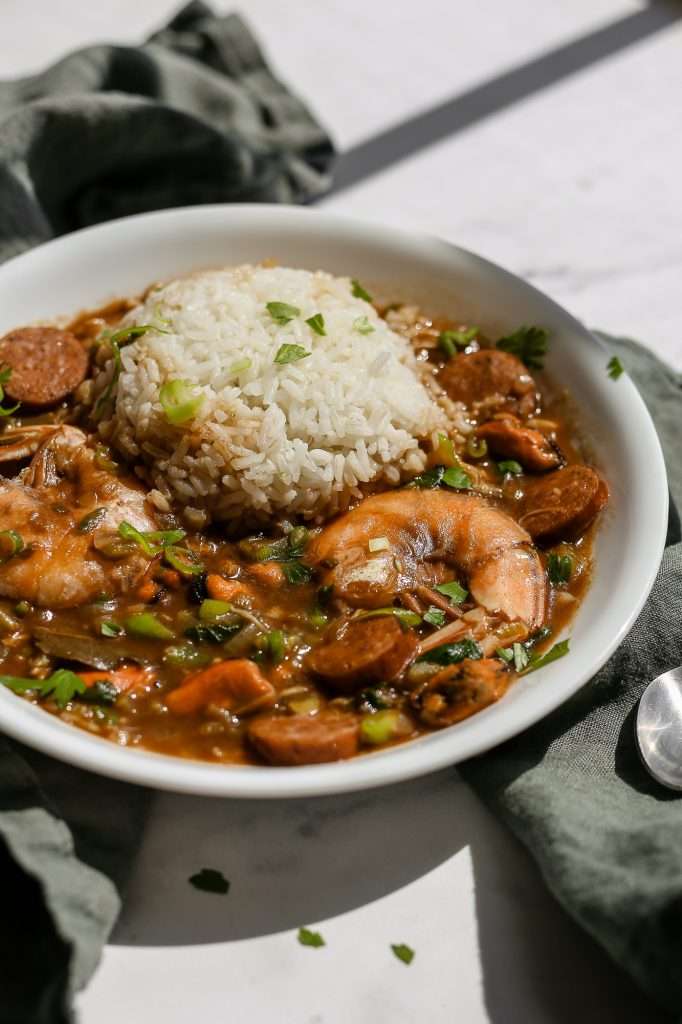
Crab Gumbo Variations
Creating the perfect cajun seafood gumbo is an art, and choosing seafood combinations plays a crucial role in achieving that delectable harmony of flavors and textures. While there’s room for personal preference, some combinations are classic and celebrated for a reason. Here are a few variations you can try with this recipe:
- Shrimp and Crab: A timeless duo, shrimp and crab are the cornerstone of many seafood gumbo recipes. Together, they add complexity to the gumbo, with the shrimp’s tenderness and the crab’s briny sweetness marrying beautifully in the pot.
- Oysters and Fish: To introduce a more oceanic depth to your gumbo, consider the combination of oysters and fish. The oysters contribute a briny essence, while the fish, such as catfish or snapper, provide a flaky, tender texture. The combination adds flavor and variety, creating a truly rich and dynamic gumbo. (this combo is also more affordable if you’re on a budget!)
- Crawfish and Scallops: the combination of crawfish and scallops is always a winner. Boiled crawfish tails infuse the gumbo with spice, while scallops contribute a melt-in-the-mouth tenderness and a delicate, slightly sweet note.
- Lobster and Clams: For a gourmet twist on this gumbo, lobster and clams provide a luxurious combination. The lobster’s sweet and succulent meat pairs elegantly with the briny clams, creating a seafood gumbo that’s rich and indulgent.
The possibilities are as vast as the Gulf, and you can experiment with your favorite seafood combinations. These classic pairings, however, are a fantastic starting point for crafting a cajun seafood gumbo that is bound to delight.

The History of Cajun Seafood Gumbo
Gumbo, a quintessential dish of Southern cuisine, carries a rich tapestry of history deeply rooted in African culinary traditions that have shaped American cooking.
The word “gumbo” has origins in West Africa. “Ki ngombo” in the Bantu language of Central Africa means “okra,” a primary ingredient in many gumbo recipes. It’s from this linguistic connection that the dish draws its name, underscoring its African heritage.
The African influence on gumbo extends far beyond nomenclature. The dish’s essence lies in combining diverse ingredients to create a harmonious, flavorful whole, a practice inherited from African culinary traditions.
In the American South, enslaved Africans brought their knowledge of cooking techniques and ingredients like okra, rice, and various meats and seafood. These elements melded with the local ingredients and European influences, leading to the emergence of gumbo as we know it today. (I highly recommend watching the documentary High on the Hog to learn more!)
The gumbo pot mirrors cultural fusion in the American South, showcasing the African, French, Spanish, and Native American influences that have shaped the region’s cuisine. As a testament to the resilience and creativity of African cooks who worked under the harshest conditions, gumbo is a culinary symbol of cultural preservation and adaptation. It remains a beloved dish, cherished for its history and complexity.

What to Serve with Cajun Seafood Gumbo


Authentic Cajun Seafood Gumbo with Crab, Shrimp and Mussels
An easy, one-pot recipe for authentic Cajun seafood gumbo made from scratch with a dark roux and local seafood. This is a crab gumbo with mussels and shrimp, but you can use other seafood in this recipe. (I’m a Cajun, from St. James Parish, Louisiana, so this is genuine Cajun seafood gumbo).
- Prep: 30 minutes
- Cook: 3 hours
- Total Time: 3 hours 30 minutes
Ingredients
- 1 cup organic flour
- 1 cup tallow or lard
- 2 large yellow onions, chopped
- 2 green bell peppers, chopped
- 8 celery ribs, chopped
- 1 cup of warm water
- 2 tablespoons fermented hot sauce (optional)*
- 12 ounces smoked andouille sausage, sliced
- 1 tablespoon cajun seasoning*
- 1 teaspoon fresh oregano, chopped
- 1 tablespoon garlic powder
- 1 tablespoon onion powder
- 6 cloves of garlic, minced
- 8 bay leaves, whole
- 8 cups beef stock*
- 1/2 cup fresh parsley, chopped
- 1 cup green onions, chopped
- 1 lbs shrimp*
- 1 lbs mussel meat
- 1 lbs crab meat
Instructions
- Prepare the onion, bell pepper, and celery (trinity). Measure your flour.
- Gather your 1 cup of water and place it near where you are cooking DO NOT USE IT YET. Place the chopped trinity near your cooking pot as well.
- Add the tallow to a large stock pot and heat over low-medium until it’s fully melted and hot.
- Slowly sprinkle the flour into the hot tallow while stirring continuously with a wooden spoon or roux spoon. Watch closely and do not stop stirring until the mixture (Roux) has turned a dark chocolate color. (See body of the blog post for roux progress photos)
- Add onions, bell pepper, and celery and stir to combine. Take your cup of water and drizzle tiny bits as needed to keep the roux mixture smooth and not clumpy. Cook until the aromatics are translucent.
- Add Sausage and hot sauce (hot sauce is optional) mix together, cooking for about 3 minutes.
- Add the Cajun seasoning, oregano, garlic powder, and onion powder and stir to combine.
- Slowly add the stock, stirring continuously.
- Add the bay leaves and fresh minced garlic and bring to a boil.
- Immediately turn the heat down to a low simmer and cover.
- Allow to simmer for about 2 hours.
- While simmering cook some rice.
- After simmering, add crab, shrimp, mussels, green onion and parsley and bring back to a low boil. Cook for 15 minutes then turn off the heat.
- Taste test and salt to taste.
Notes
- The stock is flexible, you can use beef, chicken, vegetable or seafood stock. I think beef stock is best.
Use additional stock for a thinner gumbo, or less for a thicker gumbo. Depending on your preference. - Some Cajun seasonings have salt, some do not, that is why it’s best to salt to taste after cooking. Louisiana Cajun Seasoning is my favorite.
- Hot sauce is optional. If you like you gumbo spicy I highly recommend.
- I prefer to add shrimp with the peel on to my gumbo. It adds more flavor.




















This gumbo is definitely one of the best that I’ve ever had and that’s coming from someone who grew up in Cajun country but also has played around with more creole gumbo recipes as well — this one will be added to my rotation!
I think making a seafood stock from the shrimp shells is an improved approach to eating the gumbo without making a total mess with your hands and getting the flavor you’re trying to attain!
“total mess with your hands” made me giggle lol. We have many crawfish and shrimp boils every spring, so peeling a cooked shrimp from a bowl of gumbo in the winter is no different. Thank you for leaving a review!